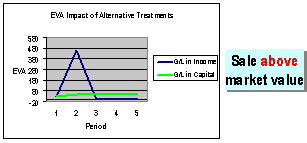Option 2: Capitalizing gains and losses on disposition
This treatment would add any gains or losses back to income and capitalize said gain or loss into net assets in a separately tracked account.

A capitalized gain has the effect of credit would
exceed that EP if the sale was value creating and  fall short if the
sale destroyed value. The same would be true for a loss on sale, i.e.,
the capital charge on the loss should resemble the foregone EP losses,
etc.
fall short if the
sale destroyed value. The same would be true for a loss on sale, i.e.,
the capital charge on the loss should resemble the foregone EP losses,
etc.
 Treating gains and losses on sale as capital events better matches
operating improvements relative to gains. This treatment, therefore,
should negate the behavioral issues previously encountered.
Treating gains and losses on sale as capital events better matches
operating improvements relative to gains. This treatment, therefore,
should negate the behavioral issues previously encountered.
However, this adjustment does require administrative effort. Capitalizing all disposition transactions may be impractical since many of them are fairly small. Thus, we must agree upon either one or more classes of assets being subject to this treatment, a threshold size of asset or sale, or treatment of major dispositions on case-by-case basis.
As these administrative details are considered, it will become plain that this treatment is far from an all-or-nothing choice. Many dispositions will necessarily be left unadjusted. But left unadjusted, large non-recurring gains will create huge growth in EP in the year of the gain, then a large drop in the following year as the non-recurring event, in fact, does not recur.